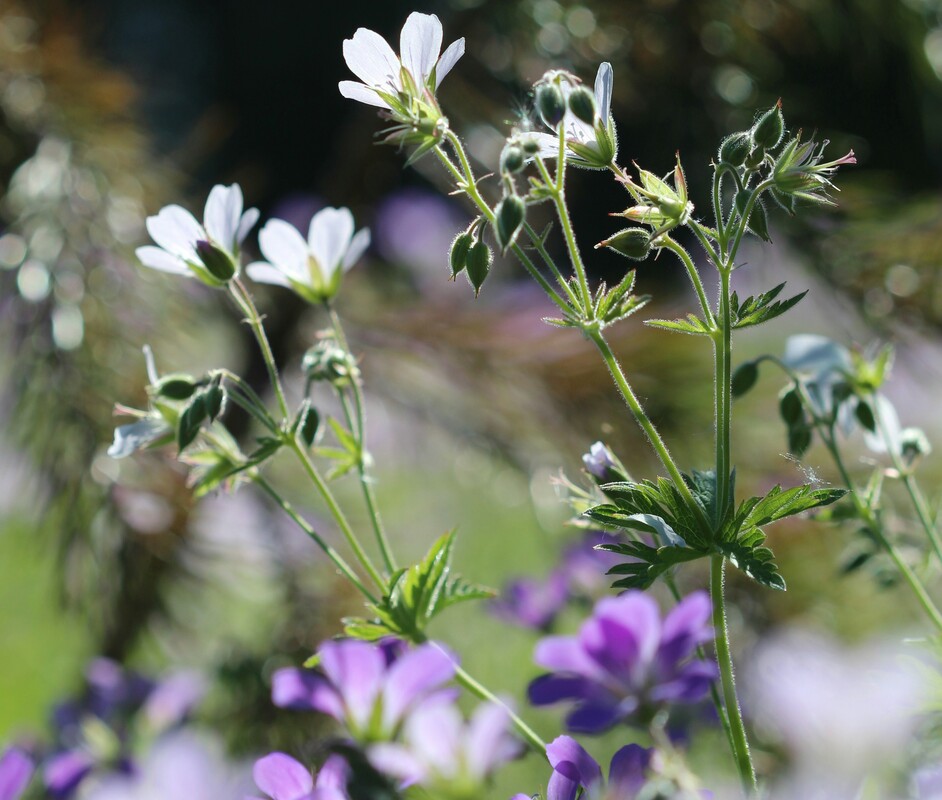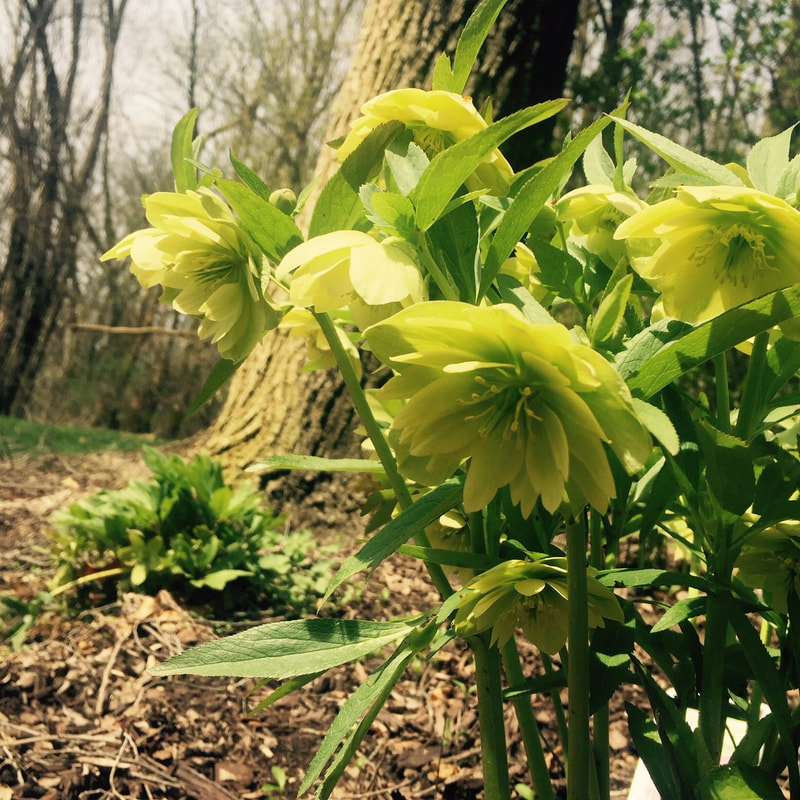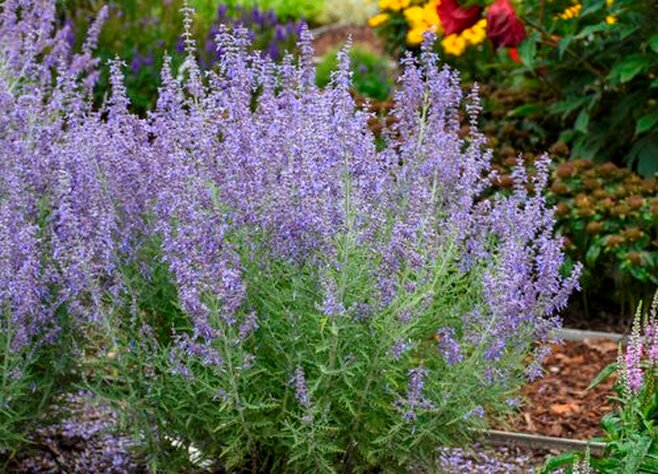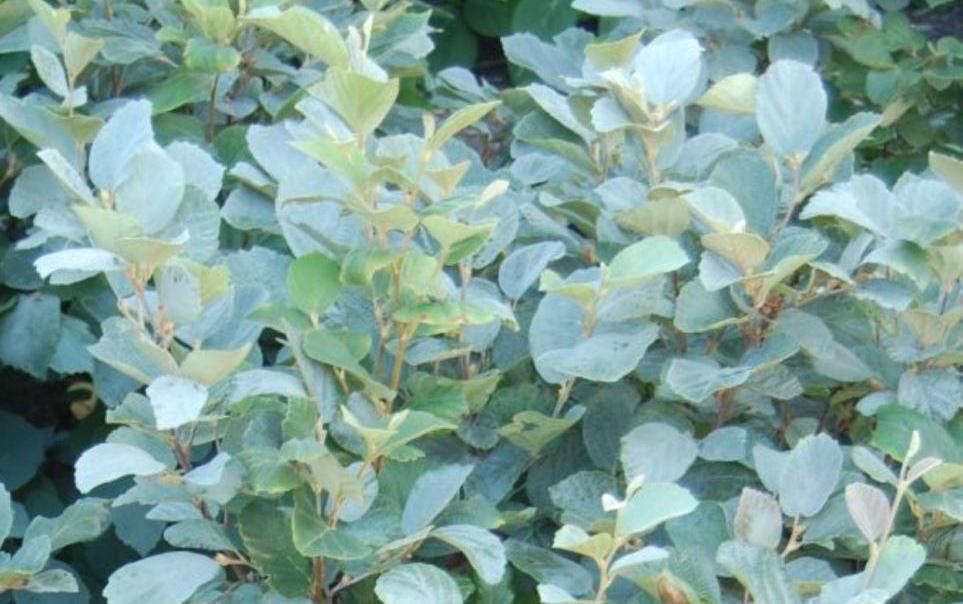|
Soil is the foundation of all the plants you grow. If your soil is healthy, your plants are healthy. Why is that? Soil is alive with thousands of microorganisms that are working to keep nutrients available for your plants at the root level. If soil is left uncovered, those microorganisms can be exposed to sunlight, the top layer of soil can erode away, leaving plants at a disadvantage without a layer of insulation.
So we mulch. We have yards of hardwood mulch applied every year, and while this is a widely-accepted practice, there are better options that benefit the plants, the pollinators, and you. In ecological gardening, we are trying to mimic what nature does and restore wildlife habitats. In a natural ecosystem, you will rarely find exposed soil. Typically there is a layer of leaf litter that naturally falls, and within that layer are beneficial insects and their eggs that overwinter. ‘Leave the leaves’ has been a recent campaign by conservationists, and it makes sense. Not only do leaves help suppress weed seeds, but they nourish the soil as they break down and provide habitat for wildlife. Another option is a living mulch. Using plants as a mulch has many benefits - one of them is less weeding. When the right perennials are planted closely together, they will cover exposed soil and crowd out weeds. There are wonderful grouncovers that can be used as mulch as they weave in and around perennials and shrubs. In keeping with the last article ‘Grow the Right Plants’, we want to make thoughtful choices taking into consideration not only aesthetics, but also benefits to pollinators and plant communities. Introducing matrix plantings. A matrix is a design concept that originated in Germany following WWII. In it’s simplest form, a low-growing perennial is used as a groundcover, then taller perennials with similar cultural needs are planted among the groundcover to offer seasonal interest. Plants are carefully chosen based on their plant growth so they will knit together and form a cooperative ecosystem. Sedges (Carex) are commonly used as the matrix base layer. Other options include low-growing hardy geraniums (Geranium sanguineum), and lambs’ ear (Stachys byzantina) for sun, wild ginger (Asaram canadense) for shade. If you want to learn more about matrix planting design, click here. Learn more about sedges here. Living mulches can also be edible whether in an ornamental landscape or the vegetable garden. Wild strawberries (Fragaria virginiana) and herbs are good examples commonly used in permaculture. Learn more about permaculture here. The possibilities of living mulches are many and fun to explore. Next week we will focus on attracting beneficial insects. Also, watch for an opportunity to continue the conversation in person here at Burlington Garden Center coming soon. Until then, check out the links below to learn more. LINKS: What is Ecological Gardening Homegrown National Parks Native Plant Finder
0 Comments
After winter’s long hold, the first signs of spring are the sweetest. Despite the transitioning temperature swings as the two seasons duke it out, a late snow or frost will not hurt early-emerging perennials. Imagine the ground thawing, birds singing, and the sun warming as we walk through the shade garden in early spring. Prepare yourself for the thrill of excitement that only nature can provide. . . One of the first to awaken is the Lenten Rose (Helleborus). In mid-March, brush away the layers of leaf mulch and you’ll find new leaves emerging followed quickly with whites, creams, pastels or deep purple flower buds low hidden under last year's foliage. As the ground warms, foliage and flowers expand to their full glorious selves rising to 12-24 inches. A new one to look for is H. 'Sun Flare'. Plant them along a pathway and on a slight slope in part shade to keep them happy. Though Hellebores can be pricey, the reward is well worth it. Following quickly on their heels is Lungwort (Pulmonaria). Delicate blossoms range from white to shades of raspberry. Their attractive leaves are speckled, spotted, or splashed with silver and will expand as the season progresses making this shade perennial a good alternative to Hostas. 'Twinkle Toes' is a delightful variety that sparkles in the shade. A fascinating change happens to the flowers when pollinated. After a bumblebee nestles in to collect nectar, the flower changes color, signaling to other pollinators to find another bloom. Isn’t nature fun? A lovely companion to the pinks and purples of Lenten Rose and Lungwort are the sky-blue dainty flowers of False Forget-me-not (Brunnera). Like her shady sisters, it is flowers before foliage in the spring. The species will often reseed and after a few years, the garden will be a sea of blue. Once the initial show is done, the foliage expands into attractive hearts that grace the landscape. Look for variegated varieties with white or silver like 'Sea Heart' which won’t spread as quickly. Primroses (Primula) are a seasoned harbinger of spring. Their lovely pastel flowers embody the hope and joy that spring brings. Many Primula species are self-seeding and create a naturalized feel in the shade garden. In addition to the low-growing posies, look for the taller drumstick or candelabra types to add variety. Two other favorites to look for are the apricot, double blossoms of ‘'Nectarine' that will dance their way into your heart, and the frilly, apple-green ‘Francesca’ which blooms a little later than other Primrose. What spring garden would be complete without unfurling fiddleheads? Like a child, I often find myself on my knees with my face pressed in close to capture those fresh, green fronds with my camera. But green is not the only color of ferns. Pepper in the burgundy, lacy foliage of Japanese Painted ferns and all her offspring varieties. They make a lovely contrast to the emerging, broad leaves of Hosta. In the summer, the shade garden cools us with calm, green hues and a mix of bold and fine textures. It’s in spring when she arises and shines with an entirely different color palette. With a few of these early beauties in your landscape, you can more fully experience the excitement of spring as the earth awakens.
Tracy Hankwitz is a horticulturist and general manager at Burlington Garden Center. 2/9/2020 0 Comments Award-winning Plants for 2020It's always fun to see the plants that receive special recognition each year. This year is especially interesting as the perennial of the year and the hosta of the year are both shade lovers and both have striking chartreuse coloring. The 2020 Perennial of the Year, awarded by the Perennial Plant Association is Aralia 'Sun King' (shown above). 'Sun King' is a beautiful addition to the shade garden growing at least 3 feet tall and wide every year. In late summer it produces tiny white flowers that are followed by deep purplish black berries (that are inedible). 'Sun King' is deer resistant and the flowers attract honeybees. As you can see from the photo above, Hosta 'Dancing Queen' glows in the shade garden. Chosen by the American Hosta Association as this year's hosta of the year, the chartreuse foliage is stunning! The ruffled margins and deep, corrugated veins make her dance in the garden. She grows 22 inches tall and up to 40 inches wide. The International Herb Association is celebrating it's 25th anniversary this year and has chosen Rubus spp. as it's herb of the year. The Rubus family, which includes raspberries, blackberries, and other brambles, may not seem much like an herb, but the roots and canes have useful qualities in addition to the fruits. The leaves have medicinal qualities and have been used in teas. It's about time this yummy fruit gets some attention and is celebrated. Since 2016, Proven Winners has had their own set of award-winning plants. Those receiving top honors include Perovskia 'Denim and Lace' shown above. Euphorbia 'Diamond Frost'took top place among annuals, and Hydrangea 'Invincible Ruby' was chosen best among shrubs. To see their complete list of winners, click here. Finally, every year the National Garden Bureau declares it's Year of the . . .' for each category including vegetables, annuals, herbs, perennials, and flowering shrubs. This year has been deemed the Year of the Hydrangea. We can't think of a better choice! To see their complete list of winners, click here.
A Field Guide to Raising Butterflies
There is a magical process that takes place starting in late spring through fall in our area. It is the complete metamorphosis of a monarch caterpillar to a butterfly. Looking at the caterpillar, one of the first things that goes through your mind is how does this striped caterpillar become a butterfly? What part of the caterpillar is the wings? Which part is the thorax? Do the legs become wings? It is a wondrous process to witness the transition. When it breaks through the chrysalis and crawls out, the monarch's wings are completely crumpled up. The thorax or body is huge and filled with fluid. It’s first moments as a butterfly are spent pumping fluid from the thorax to fill and expand the wings. You have to be quick to capture the process. After it looks like a typical monarch, it will rest and occasionally flap its wings to dry them. A few years ago, I started collecting monarch eggs or small caterpillars and started bringing them inside. Why would I do that? One more thing to take care of, one more thing to worry about. But if you have heard the news, you know monarch populations have dropped off considerably. We have good years, but overall, there are fewer monarchs. There is a strong statement typically made about monarchs, that they produce a taste that is offensive or toxic to predators. That is true to an extent, but predators get around that sticky issue. First, ants, tree frogs and other predator insects will eat the entire egg. If the monarch survives to hatch, it may still be consumed by those insects and tree frogs. The bluebird has apparently learned how to eliminate the toxic part of the caterpillar so it can be fed to its hatchlings. That leads to the conundrum of who is more important; the bluebird or the monarch? No fear, by bringing the caterpillars inside your home or inside a protected enclosure, the monarch is protected from food predators. But more importantly it protects them from being infected with one of several diseases which also kills the monarch. So what can we do to make it easier for the monarch if you cannot provide them a protected home? Giving them plenty of native plants along with various forms of milkweed is a great way to start. Plants like Joe Pye Weed (Eupatorium or Eutrochium macrolatum), Meadow Blazing Star (Liatris ligulistylis), and Lead Plant (Amorpha canescens) along with many more, will feed your monarch butterfly once it is released. Milkweed or butterfly weed (Asclepias tuberosa) is important for the butterfly to lay eggs, so keep those within an area of your yard. If you find common milkweed too invasive, swamp milkweed(Asclepias incarnata) is an excellent substitute that is native to our area and is less invasive. We still have many monarchs to marvel at as summer slowly wanes. Look for chrysalises on Milkweed plants, watch the butterflies emerge, and make plans to actively raise them next year. Beth Martin is a Master Gardener here at Burlington Garden Center where you will find many plants helpful to the butterfly lifecycle. Feel free to contact Beth at [email protected]. ‘I must have flowers, always and always’ wrote Claude Monet. How many of us can’t identify with this sentiment? It’s the rose, the peony, the lily that make us catch our breath and stop to look twice. Isn’t that what we wait for all winter and spring? Planting annual flowers into containers to welcome us home every night or a garden bed filled with summer blooms give immense pleasure. Yes, like Monet we must always have flowers, yet there is something noteworthy and plausible about plants with terrific foliage. When the spring perennial flowers have faded, what makes the shade garden interesting? Hostas, Coral Bells (Heuchera), and ferns (especially Japanese Painted Ferns) carry us through summer and fall with variegated leaves, colorful foliage, and contrasting textures. Consider this: as perennials bloom their allotted times, some only a week or two, what do they look like when they are done flowering? How does that affect the look of that garden bed? And on an even broader scope, how does your landscape look when nothing is flowering? Adding a few perennials and shrubs with colorful and interesting foliage can take your garden from good to great design. After a quick poll of our staff at Burlington Garden Center, here are a few of our favorite foliage plants: CHARTREUSE FOLIAGE Aralia cordata ‘Sun King’ (above) is definitely king in the part shade or shade garden. This herbaceous perennial (Spikenard) will quickly grow to 3’ tall in ideal situations and its broad leaves bring a bold chartreuse color among hostas and hydrangeas. Hakonechloa macra ‘Aureola’ is a fine-leaf grass for the shade garden. This Japanese Forest Grass cascades over boulders, softens front of the border, and pairs well with Hostas. For the sun garden, a splash of chartreuse foliage can be provided by Agastache ‘Golden Jubilee’ even when not topped with purple flowers often covered with bees. BURGUNDY FOLIAGE Hummingbirds aren’t the only ones that love Penstemon digitalis. The burgundy leaves of ‘Husker Red’ and ‘Pocahontas’ are a pretty contrast when planted near green-leaf perennials. The Ninebark family (Physocarpus opifolius) seems to add new members every year, and each with attractive foliage – from deep burgundy, to amber, gold and copper tones. With different mature sizes, there is sure to be one for your yard. Coral Bells (Heuchera), like the one shown above, certainly are a go-to foliage plant for part-sun/part-shade. Burgundy, purple, caramel, silver and shades of greens are all pretty additions to the garden as well as to containers. Heuchera ‘Mystic Rose’ and ‘Green Spice’ are reliable varieties to look for. BLUE FOLIAGE Two plants with blue foliage combine well with that of burgundy-leaf plants: Fothergilla ‘Blue Shadow’ (above) is a medium size shrub for sun and part shade. With bottle-brush flowers in spring and beautiful red fall color, it adds interest to the landscape for three seasons. Several varieties of Hosta are easy-care perennials that bring the blues to shady gardens, too. VARIEGATED FOLIAGE
Once again, it’s Hosta that provides foliage-interest in the shade. Never settle for plain green again! Endless combinations of white, green, blue, yellow, chartreuse make this plant family far from boring. Our last suggestion for the shade garden not only offers interesting green and white foliage, but a unique, gracefully arched habit. Variegated Solomon Seal, Polygonatum ‘Variegatum’, spreads by rhizomes and will create small colonies over time. 3/12/2019 4 Comments A Few New to Sow & Grow'Though I do not believe that a plant will spring up where no seed has been, I have great faith in a seed . . .' -Henry David Thoreau Mid-March signals the beginning of the seed sowing season. Our seed racks are full of varieties ready to grow in your garden and produce a bounty of vegetables, herbs, and flowers. Following are a few of our favorite vegetable varieties new to BGC this year: Though yellow beets are nothing new in the vegetable garden, 'Golden Boy' Beets are worthy of a mention. 'Golden Boy's yellow-orange flesh is packed with vitamin A, vitamin C, beta-carotene, fiber, and iron to name a few. It has a mild flavor and won't stain like the red beets. The dark green leaves can be eaten when young and tender, and up to one-third of the outer leaves can be harvested without damaging the growth of the beet. Start in ground 2-4 weeks before the average last frost date. Sow again in late summer for a better harvest in the fall. * Two sweet corn varieties have caught our attention: 'Painted Hill' and 'Martian Jewels'. 'Painted Hill' is a cross between Indian corn and sweet corn ('Painted Mountain' x 'Luther Hill'). The color is pale when eaten fresh and has an old-time sweet corn flavor. The coloration intensifies if left to dry. With it's roots in the Rocky Mountains, 'Painted Hill' is adapted to our short growing season and will germinate in cool, wet soils which is an added bonus. * What makes 'Martian Jewels' sweet corn so special? This open-pollinated variety has Native American Hopi blue corn as a parent and is loaded with antioxidants. The violet-colored husks envelope creamy white kernels that have a sweet flavor. If ears are left longer on the plant before harvesting, the sugar subsides and the corn is perfect for bread and chowder. Dried kernels can be used for flour. Read here for more tips on growing corn. * 'Festival' acorn squash is as pretty as it is tasty. The 1-2 lb size is perfect for an individual serving. Plants are more compact than other acorn squash varieties and are heavy producers. 'Festival' will keep its flavor up to three months after harvesting. Learn more about growing squash here. * Caution: The description on the seed packet of 'Honeynut' winter squash may leave you drooling. This miniature butternut squash is a recent introduction from Cornell University. Bred specifically for the farm-to-table movement, the challenge was to create a personal-size butternut squash that had amazingly sweet flavor. After 6 years of trialing, a cross between butternut and buttercup successfully produced 'Honeynut'. The plump 4-5" fruits will signal when ready to harvest by changing from green to terra cotta. The plants also boast resistance to powdery mildew and squash-vine borer. * 'Inca Jewels' roma tomato is a Renee's Garden Seed exclusive. It was bred to be highly productive and suitable to grow in containers (tops out at about 3 feet). The juicy, delicious fruits are great for sauce or on the grill. Learn more about growing tomatoes in containers here.
2/5/2019 0 Comments Award-Winning Plants for 2019Winter is the perfect time to think about spring, the garden, and new plants to add to your mix. But how does one choose from all the varieties that are available? First and for most, consider your light conditions – not only is it sun or shade, but when is it sunny? Morning sun is very different from afternoon sun which is very different from all-day sun. Then I suggest looking to plants that are long-flowering or strong performers in the garden. The best place to look is at the lists of award-winning plants. Following are this year’s winners. HOSTA OF THE YEAR Those of you with shade gardens may be tired of hostas, but this year’s winner is worth taking a look at. ‘Lakeside Paisley Print’ not only is the Hosta of the Year, it also won the popularity vote among the American Hosta Society members, which means it is loved by everyone. Maybe it’s the dark green, wavy, heart-shaped leaves with the interesting feathery pattern of cream that’s so alluring. This medium- size hosta grows 10” tall and 20” wide and does well in part sun to shady conditions. HERB OF THE YEAR For years the Herb Society of America has selected an herb of the year, and this year is no different. Agastache takes top honors in 2019 which some would say is long overdue. Agastache foeniculum (also known as anise hyssop) is part of the mint family and is most often used in herbal teas. The leaves have a licorice/anise flavor with hints of basil. This is one herb that should be allowed to flower. Not only are the flowers edible, but the long candles of florets attract bees and other pollinators. Although it is hardy here in Wisconsin, it is considered to be a short-lived perennial, but worth planting if it doesn’t reseed. PERENNIAL OF THE YEAR It’s always exciting to see which perennial is chosen by the members of the Perennial Plant Association. This year’s is a darling in the full-sun to part-shade garden – Stachys ‘Hummelo’. It’s pretty magenta wands dance above compact mounds of attractive foliage. And though deer find it distasteful, pollinators find it irresistible. ‘Hummelo’ looks best when planted in drifts with ornamental grasses, Echinacea and Helenium. OTHER HIGH-HONOR PLANTS It seems as though every grower is developing their own award program. Particularly noteworthy are the award-winning shrubs crowned by Proven Winners this year. Keep your eyes open for Aronia ‘Low-scape Mound’ Aronia (chokeberry), ‘Firelight’ Hydrangea, and ‘Sonic Bloom’ Weigela. They take top honors for performance, reliability, and disease-resistance and deserve a spot in your landscape. Tracy Hankwitz
Horticulturist and general manager of Burlington Garden Center where you’ll find most of these award-winning plants this spring. 10/1/2018 1 Comment Great Pairings in the GardenOk, it isn't actually wine that we'll be pairing in this article, but you could enjoy a glass of it while you read this or as you are planting. Just as Pinot Noir compliments grilled salmon and Zinfandel pairs well with barbecued chicken, spring bulbs can compliment perennials with some thought and planning. Following are three ways to approach well-designed pairings. One category of pairings is bulbs and perennials with similar foliage. Hiding the dying foliage of spring bulbs is an important factor in these perennial/bulb combinations. For example, two of the easiest masquerading combos are daylilies with daffodils (see above) and tulips with hostas (see below). The pairs have similar foliage allowing for quick cover-up as the daffodils and tulip foliage die back and the new leaves of daylilies and hosta emerge. Imagine seeing the combination above in the same space in your garden but at different months of the year! Another benefit of planting daffodils among the daylilies is that they will discourage deer from eating the daylilies. * Other perennials make great pairings because of their interesting spring foliage. Many perennials don't bloom until summer but have interesting leaves in the spring. Imagine flowers of spring-blooming bulbs rising above those leaves and then disappearing just as the perennial comes into bloom. This extends the color and interest in your landscape for another season without taking up more garden space. Lady's Mantle (Alchemilla mollis) & orange tulips (see below) would be stunning together in the garden especially with a burgundy barberry added to the scene. My favorite accidental combination that turned out amazingly well was when I planted the large bulbs of Allium 'Schubertii' amongst an area covered with variegated Dead Nettle (Lamium). It was striking as well as whimsical. Hostas & Purple Allium like 'Globemaster' make great partners in the garden. And doesn't this burgundy leaf Coral Bell (Heuchera) & these pink tulips make a pretty match? * The final group of great pairings are those with the same bloom time. It can be tricky to do but with experimentation, you can come up with outstanding combinations. Imagine orange Oriental poppies with dark purple 'Queen of Night' tulips - dramatic and delightful. Here are a few more great pairings of perennials and spring bulbs: * Penstemon & Daffodils - the dark burgundy foliage of 'Husker Red'or 'Dark Towers' looks especially fabulous with yellow daffodils nearby. * Hardy Geranium & Grape Hyacinths (Muscari) * Creeping phlox & Grape Hyacinths (Muscari) - see photo below * Golden Bleeding Heart & pink tulips - see photo below Fall is the time to purchase spring-flowering bulbs and tuck them in the ground. In fact, if you are planting perennials now, throw a handful of bulbs in the same hole. Work smarter, not harder. And a final thought: just as a fine wine paired with the right entree provides a pleasurable dining experience, planting thoughtful combinations of bulbs and perennials can give your garden a well-designed look. Tracy Hankwitz Horticulturist and General Manager of Burlington Garden Center www.burlingtongardencenter.com What words come to mind when you see peonies in bloom? Lovely, charming, romantic? Often these old-fashioned favorites stir up memories of days from our youth. Let us introduce you to a few new varieties that would make a welcome addition to any garden. * Let's begin with two stand-bys in our perennial house: Sarah Bernhardt and Festiva Maxima (shown above) -both herbacious varieties (Paeonia x lactiflora) with fully double blossoms. Sarah's fragrant pink blossoms have been gracing gardens and vases for 100+ years! She's a classic. The white blossoms of 'Festiva Maxima' are another fragrant peony enjoyed by several generations of gardeners. * For something a bit more unusual, try your hand at tree peonies (Paeonia suffruticosa). Like the name suggests, they have a woody stem, huge flowers, and can grow to 5 feet. Tree peonies are hardy in Wisconsin and a mature specimen can have up to 80 flowers. According to peony breeder, Roy Klehm, they can also do well in partial shade. We are offering "Lavender' Tree Peony this season (shown above). One look at the blossoms and you'll be charmed. * Now put the two together (herbacious and tree peonies) and you get an ITOH peony or intersectional hybrids. Named after the breeder Toichi Itoh, these peonies grow to 3 feet, require no staking, have disease-free foliage and up to 50 gorgeous blossoms on a single plant! Itoh peonies can be a bit pricey, but their luxurious blooms and spicy fragrance are well worth it. This year we have the following Itohs (shown above):
Bartzella - Very large, bright yellow double blossoms with a lemony scent. Keiko (which means Adored) - dark lavender pink petals slowly fade to a soft pink, revealing a cluster of yellow stamens in its center. Like other Itoh peonies, 'Keiko' will die back to the ground after the fall frost. Old Rose Dandy - a cross, with both P. lutea and P. suffoticosa, is a robust grower with glossy dark green foliage on a medium size, rounded bush (2 1/2 tall). Flowers are single form in a shade of copper apricot that lightens to a yellow beige as they age. * Peonies flower best in full sun and make wonderful cut flowers. They rarely need to be divided but if necessary, it's best to do it in the fall. * And what about those ants? Ants are attracted to the sweet nector produced by the peony buds. They won't harm the flowers! Once the flowers open, the ants are gone. 5/8/2014 2 Comments Clematis for ContainersBig, bold, and lovely. Those words describe the clematis from the Raymond Evison Clematis collection. Add to that: long-blooming and partial shade lovers. Mr. Evison has spent more than 50 years breeding the world's best clematis and has introduced more than 100 cultivars. His most recent introductions have been compact and suitable for containers (pots with 18" diameter are a good size). Following are a few that we are proud to carry this season: 'Alaina' has deep, creamy pink flowers, grows to 4 feet, and blooms in late spring and again in late summer. Flowers will last longer in a shady afternoon location. * 'Cezanne' is a blue flowering variety that grows 3-4' tall and likes a partially shady spot. * Superb repeat flowering performance and lovely violet blossoms with red centers make 'Parisienne' a must have. Another compact one great for containers, it will bloom from early to late summer. * 'Ice Blue' has dramatic large flowers May-June and again in late summer. Grows to 6' and is ideal for east, west, and north facing locations. * 'Shimmer' rounds out our collection with it's 7" deep lilac-blue flowers. Plant this long-blooming perennial to grow on pergolas or trellis with roses. Grows 6-8 feet.
All of these clematis are easy to prune - just cut back to 12 inches in the spring. Plant them deep with annuals or perennials planted at their feet. * Why not start your own collection of Ray Evison Clematis this spring? 4/25/2014 3 Comments A Spring Beauty: HelleboreHellebores, also known as Lenten Roses, are one of the first perennials to bloom in the spring. They are deer resistant and drought tolerant and prefer a part-shade location. Hellebores, like the 'Ivory Prince' above, look lovely with several varieties planted together under a tree or at the edge of the woods. Other good companions include Lungwort (Pulmonaria), Bugleweed (Ajuga reptans), and hostas. * In addition to 'Ivory Prince', we are offering the following Hellebore varieties: The blossoms of 'Mango Magic' are a unique qpricot color often having spotted petals. * 'Red Racer' has dramatic 5-inch flowers that look good with Ghost fern, Sweet Woodruff, and Moneywort. * 'Peppermint Ruffles' features 3-inch, double-petaled blossoms. It is a vigorous bloomer and has strong stems. * 'Sunshine Ruffles' is a knockout with its double yellow, 3-inch blossoms that can last from March until June.
* Hellebores may not bloom the first year in your garden. Be patient! They are long-blooming and long-lived perennials - a spring beauty well worth the investment. * All photos courtesy of Hoffienursery.com. |
|
|
STORE INFO
5205 Mormon Road Burlington, WI 53105 262.763.2153 |



















































